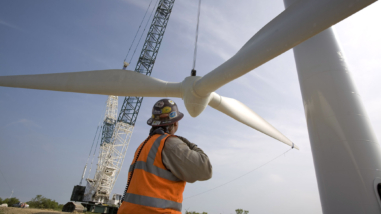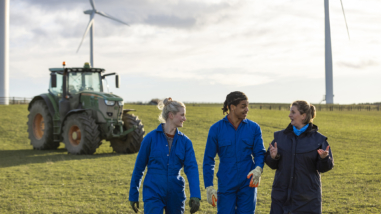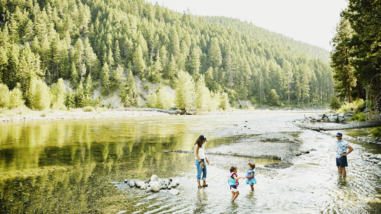Restoring waters and building momentum: Four years of the Open Rivers Fund

A free-flowing river has an aura of inevitability.
As creeks and small streams merge into one, the river finds its way. Left to its own devices, it goes where gravity says it must – scouring its own banks, starting course changes when obstructed, and moving material to rebuild its bed. On its way, gaining volume and power, it sustains communities – human, aquatic, and terrestrial. The natural path tends to be the right one.
Of course, most rivers in the West are not free flowing along their entire course. To restore river health, the Open Rivers Fund was launched by Resources Legacy Fund (RLF) in late 2016. The Fund is a 10-year effort supported by a $50 million grant from the William and Flora Hewlett Foundation.
The Open Rivers Fund, together with several Hewlett grantees, supports local community efforts to remove obsolete dams and other river obstructions, modernize water infrastructure, and restore rivers to benefit local economies, cultures, and fish and wildlife habitats across the American West. RLF works with partners that engage openly and collaboratively, with a commitment to ensure a wide range of local voices is heard. Over the long haul, this work, in all of its forms, is about building resilience.
The Fund is pursuing work that is intentionally diverse. In a region with rain forests, deserts, high plains, cold water streams in arid canyons, and a relentless thirst for agricultural and industrial water, one size will not fit all. State laws differ, as do bodies of water, local infrastructures, and community needs, suggesting a need for multiple approaches.
The work so far has a riverine quality. Beginning with a small set of projects in three states, it has flowed across the entire West, now with projects in nine states and 44 watersheds.
By the autumn of 2020, 24 dams had been removed, opening up more than 170 river miles and thousands of acres of restored land for community parks and public access and wildlife.
The removed dams varied in size, ranging from the 70-foot-tall Eklutna Dam in Alaska to four-foot-tall temporary irrigation dams in southern Oregon. The numbers only hint at the story – the size of a removed dam doesn’t indicate the value of its benefits, and not all opened river miles are the same. The Applegate River, for example, flows freely for most of its 51 miles before its confluence with the Rogue River. The Applegate provides healthy habitat for adult fish, but is not hospitable for spawning. Removing a small dam on one of its tributaries, Forest Creek, opened up six miles of spawning habitat, making it more likely that the full river will meet its potential for hosting fish. The six miles of creek restoration can make the 51-mile river healthier, and improve both commercial and recreational fishing associated with more robust salmon populations.
Oregon: Local materials, labor and values
A dam removal and stream restoration in a downtown Ashland park benefit fish, landowners and the local economy.
Over the course of a 10-year campaign, the Open Rivers Fund aims to advance the field of dam removal and river restoration, building broader public understanding and support for both. With these goals in mind, the project also involves investments in policy development, monitoring, communications, and community engagement.
When the Fund launched in 2016, it highlighted three ambitious projects. A multi-project watershed approach in the Rogue River Basin, with the Beeson-Robeson Dam, a small irrigation diversion, was the first dam removal in September 2017. At Nelson Dam, in Washington’s Yakima River watershed, engineering studies have begun in anticipation of removal in 2021. Removing Matilija Dam, outside Ventura, California, is still several years off, given its size and complexity, but local partners see significant momentum toward the finish with design, permitting, and fundraising well underway.
Learn more about three newer projects that illustrate the breadth of the overall portfolio:
Ancestors and members of the Cowlitz Indian Tribe have lived in the region now defined as southwest Washington for more than 5,000 years. They travel in shovel-nosed, shallow-draft canoes, navigating rapids and shoals with a combination of paddles and poles. Their conical, woven-cedar hats – designed to shed intense Cascadian rains – are an iconic indigenous image of a people sustained for eons by salmon and steelhead that migrated up free-flowing rivers.
The Tribe’s ancestral fishing grounds include the lower Washougal River, which flows into the Columbia. In 1965, Kwoneesum Dam was built on a key Washougal tributary to create a recreational lake for a Camp Fire Girls’ summer camp compound. The dam blocks fish passage to 6.5 miles of prime spawning and rearing habitat; it also deprives the creek’s lower reaches of sediment and woody debris that slow stream velocity at peak flows, provide habitat, prevent erosion, and maintain healthy estuaries. Federally listed coho salmon and winter and summer steelhead are affected, as are other species of concern to the Cowlitz Indian Tribe, including eulachon and lamprey.
Washington: Collaboration to restore fish runs and culture
The Cowlitz Indian Tribe and Columbia Land Trust are restoring the Tribe’s ancestral fishing grounds.
Today, the dam serves no specific purpose – the Camp Fire Girls no longer gather there, and the area was closed as a campground in the late 1980s. The Cowlitz Indian Tribe is now partnering with the Columbia Land Trust (CLT) to remove the dam and fully restore the river.
“For our Tribe and coastal tribes, salmon is the foundation of our existence,” Tanna Engdahl, spiritual leader of the Cowlitz Indian Tribe, said. “It was one of the most amazing gifts from the Creator and kept generations alive. Our aim is to bring salmon-bearing streams back. Bringing its habitat back is honoring the earth, the Creator, and our ancestors.”
As the key first step, CLT secured control of the dam site by purchasing 1,300 acres of forest land surrounding the dam. The move permanently conserves the land, allows for access, and paves the way for the Tribe to do the work of dam removal and stream restoration. Quick action, with support from the Open Rivers Fund, was essential in enabling this transaction.
“We get these windows of opportunity to work with the landowner, in this case an industrial timberland owner who is willing to sell,” Cherie Kearney, CLT forest conservation director, said in advance of the purchase. “But they are only willing to sell in a certain time frame and under certain conditions.”
The Open Rivers Fund is supporting efforts of CLT and the Tribe, including grants to CLT to cover acquisition costs, and to the Tribe to cover dam removal design, engineering, and project management. CLT acquired the dam in March 2020; dam removal is expected to occur in 2022.
“When the fish are running, nobody goes to sleep.” According to Aaron Leggett, president of the Native Village of Eklutna, that’s what they said back when the Eklutna River teemed with salmon runs.
It’s a memory held by the Eklutna Tribe Dena’ina people, whose original lands abutted the inner reaches of Cook Inlet, and the great estuary formed by five rivers. (The city of Anchorage fits squarely within the Tribe’s original lands.)
The present reality doesn’t match the memories. For nearly a century, a 70-foot tall dam, just north of Anchorage, stopped fish passage on a river that once hosted all five of the Pacific salmon species found in Alaska. This blockage occurs even though the 90-year-old dam, built to divert water to an early hydroelectric plant, became obsolete in 1955 with completion of a tunnel to divert Lake Eklutna water.
“Salmon is a language that binds us together,” Curtis McQueen, then CEO of Eklutna, Inc., said. “And it has been the dream of the village to try to rehabilitate a river that has been going through shock and awe.”
In summer 2018, with support from the Open Rivers Fund, the Eklutna Dam was removed, opening up 22 miles of additional habitat. Removal was done by Eklutna, Inc., which was incorporated under the Alaska Native Claims Settlement Act, and owns the property surrounding the dam after an impressively efficient two-year period of design, planning, and fundraising.
“As I saw that the dam was actually going to be removed, there was such a relief from my being – like the echoes of elders subsided and became calm,” Maria D.L. Coleman, vice president of the Native Village of Eklutna Tribal Council, said.
In this case, the dam removal was not a culmination. The reason: The salmon cannot yet capitalize on the 22 miles of additional habitat because the river is largely de-watered. Dozens of miles upstream, at Lake Eklutna, nearly all of the river’s water is diverted: 10% is used for Anchorage’s water supply, and the other 90% generates electricity to supply 2% of total power on the local grid. In a typical rain year, little, if any, water is left for salmon.
Local experts say restoring salmon runs would require only 10% of the current flows above Lake Eklutna.
Alaska: Healing a century-old wound on the Eklutna
Eklutna Dam has been removed but restoring Dena’ina fisheries requires more and faster help from Alaska utilities and others.
A 1991 agreement requires the operating utilities to commit to Eklutna restoration, but on a timetable that could stretch to 2027. The Fund is supporting community outreach, research, and planning to quicken the pace, and ensure the quality of mitigation measures so that necessary flows can be restored much sooner rather than later. Momentum from the dam removal offers a window of opportunity. The Native Village of Eklutna, and the nonprofits Alaska Center Education Fund and Trout Unlimited are heavily involved in this strategic public outreach process.
Restoration will offer real value to the Eklutna Tribe, both economic and cultural, because more than half of its members live in or near the Anchorage area. It will also aid Alaskans more broadly, as salmon is vital to the state’s economy and culture.
Built in 1904 to provide water for Missoula, Montana, the 60-foot-long dam on Rattlesnake Creek in Missoula had been obsolete for decades. Fish passage was blocked much of the year, limiting access to important spawning and rearing habitat for threatened bull trout. With clear signs of decay, the dam was a public safety risk and liability to the City of Missoula. A coalition of local leaders and nonprofit partners set a clear goal: The dam needed to go.
The city took ownership of the dam in 2017 when purchasing the company that provided Missoula’s water. At that time, the city and the local Trout Unlimited chapter collaborated to divide the workload. The city focused on proving its ability to be a reliable and service-oriented water provider; Trout Unlimited began engineering and planning work for removal of the dam. This division of labor, funded in part by the Open Rivers Fund, meant that removal and restoration planning could proceed at full speed, even as the city focused on the operational issues of water delivery.
Montana: Citizen science on Rattlesnake Creek
A local grantee is ramping up citizen science efforts to capture data both before and after dam removal and build community support for restoring the watershed.
Residents of Missoula strongly supported the project in part because Missoula had already witnessed the 2008 removal of a much larger obstruction, Milltown Dam, as part of a Superfund remediation. The Confederated Salish and Kootenai tribes offered public support because dam removal would help restore bull trout runs that once provided their winter sustenance.
The planning work paid off: At the first public hearings focusing on dam removal, when detailed options were revealed, only 3% of comments questioned the value of dam removal. The quick pace meant that in August 2020, only three years after the transfer of ownership, the dam was demolished and restoration began.
Removal opens up more than 31 miles of Rattlesnake Creek, giving headwaters access to fragile populations of bull trout and Westslope cutthroats. It relieves the city of liability headaches associated with ownership of a decrepit dam. Because the dam is close to the population center, with bus stops a short walk away, the city is using the project to provide education on dam removal; a new public overlook has allowed local residents to see removal and restoration processes in real time. Many are indeed stopping by, as large numbers of Missoula’s mountain bikers and hikers make active recreational use of the Rattlesnake Creek Wilderness Area, which starts just four miles from the city limits.
The Watershed Education Network (WEN), a local citizen science stream monitoring group based in Missoula, used the dam removal to build interest in their programs, and took steps to ensure meaningful data collection from Rattlesnake Creek before and after dam removal. They rewrote field science protocols, developed by government agencies, to retain rigor but make the materials more accessible for non-scientists. They increased training requirements, and armed their volunteers with equipment that enable more precise measurements. These improvements make it possible for their work to dovetail with other physical science monitoring activities in the region. They are collaborating with the Center for Citizen and Community Science at the University of California, Davis, which developed a manual, supported by the Open Rivers Fund, to guide citizen science efforts focused specifically on dam removal and river restoration. The manual will be useful for replicating citizen science at other Fund projects.
Unlikely partnerships can have outsized impacts. When the dam removal process is respectful and inclusive, cultural shifts can occur.
Each summer, rancher Wade Lowham sustains his herd with water diverted from the Bear River in southwestern Wyoming. In an annual process he said was “a pain to put in,” he used heavy equipment to build a temporary six-foot-high dam across the river; he used the same equipment again to remove the dam before winter rains arrived. While the diversion was vital to his ranch, it was harmful to fish populations.
Lowham was a skeptical but willing partner when staff from Trout Unlimited and officials from multiple Wyoming agencies suggested a different approach. With support from the Open Rivers Fund, he no longer needs to build the dam each June – the river has been reshaped with a series of low-elevation rock lifts downstream of the dam site, raising the riverbed in a series of steps. The river looks natural, fish can pass year-round, and the raised bed allows for easy water diversion when necessary, using a modern headgate.
Wyoming: Better for fish and easier for irrigators
One definition of success is when fish habitat is improved, irrigation needs are met and the local rancher says, “This makes my life a lot easier.”
Lowham lives in a part of Wyoming where distrust of federal agencies can run high; he broke with local norms by collaborating with government agencies and conservationists. But one skeptical rancher who gains satisfaction can be key to building broad support for restoration efforts. And Lowham is satisfied – in his low-key way, he raves about the changes.
“So far this year, we haven’t had to do anything but raise the headgate up and lower it,” he said. “It made my life a lot easier.”
This pattern repeats across the West. Tom Maddox runs a sawmill on Forest Creek in Oregon’s Rogue River basin, adjacent to the dam that once blocked fish passage. He wasn’t interested when the Applegate Partnership and Watershed Council asked to visit. His family had contact with the group’s predecessor and the experience left a bad aftertaste. So, Maddox ignored their calls.
But the Partnership persisted, and Maddox let them come on site for a visit. He and his landlord ultimately agreed to a plan to move forward with dam removal. The process was lengthy: It took nearly five years from the first conversation, to creek restoration. It took time to build trust, with a breakthrough coming when it was clear to Maddox that the project team was listening to him and utilizing his intimate knowledge of the stream.
The project turned a fourth-generation resident who was profoundly skeptical into a genuine supporter of the Partnership and its mission.
“I’m really a big fan. I’d tell any of my neighbors to pick up the phone if they call. At least have that first conversation with them.”
_____________
The art and science of dam removal – of the engineering, biology, and policies involved – is still in its early stages. But through this program, and the work of many other organizations across the country, this knowledge is being accumulated and shared with communities eager to restore their rivers. Many more obsolete dams are slated for removal in coming years – and each of these actions is a tributary to a larger movement. The river gains force on its way to the sea.
Kevin Sweeney is a writer and consultant focused primarily on environmental issues. He has written for The New York Times, Los Angeles Times, Greenbiz and Salon.




